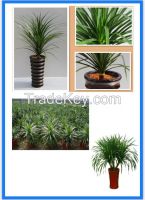Dracaena Angustifolia
- Minimum Order Quantity: 1000 Piece
- Payment Type: PayPal, Money Gram, Western Union, D/P, L/C, T/T
Product Description
Dracaena derived from the romanized form of the Ancient Greek δρκαινα - drakaina, "female dragon", is a genus of about 120 species of trees and succulent shrubs. [3] In the APG III classification system, it is placed in the family Asparagaceae, subfamily Nolinoideae (formerly the family Ruscaceae).
It has also formerly been separated (sometimes with Cordyline) into the family Dracaenaceae or placed in the Agavaceae (now Agavoideae). The majority of the species are native to Africa, with a few in southern Asia and one in tropical Central America. The segregate genus Pleomele is now generally included in Dracaena. The genus Sanseviera is closely related, and has recently been synonymized under Dracaena in the Kubitzki system.
Species of Dracaena have a secondary thickening meristem in their trunk, which is quite different from the thickening meristem found in dicotyledonous plants and is termed dracaenoid thickening by some authors. This characteristic is shared with members of the Agavoideae and Xanthorrhoeoideae among other members of the Asparagales.
D. americana, D. arborea, D. cinnabari, D. draco, D. ombet, and D. tamaranae are commonly known as dragon trees and grow in arid semi-desert areas. They are tree-sized with stout trunks and stiff, broad-based leaves. The remaining species are known collectively as shrubby dracaenas.
They are smaller and shrub-like, with slender stems and flexible strap-shaped leaves, and grow as understorey plants in rainforests.
Uses:
Ornamental
Some shrubby species, such as D. deremensis, D. fragrans, D. godseffiana, D. marginata, and D. braunii, are popular as houseplants. Many of these are toxic to pets, though not humans, according to the ASPCA among others. Rooted stem cuttings of D. braunii are widely marketed in the U.S.A. and the UK as "lucky bamboo", although only superficially resembling true bamboos.
Other uses:
A bright red resin, dragon's blood, is produced from D. draco and, in ancient times, from D. cinnabari. Modern dragon's blood is however more likely to be from the unrelated Daemonorops rattan palms.
How To Plant:
Dracaenas compose of a large group of popular foliage plants. Most grow strongly upright with long, straplike leaves variegated with white, cream, or red. Dracaenas grow well at average room temperatures but don't like cold drafts. Give plants medium to bright light to maintain best leaf color. Allow the soil to dry to the touch between waterings.
Yeven Li
Tel : 00-86-757-23323963
Fax : 00-86-757-23323999
It has also formerly been separated (sometimes with Cordyline) into the family Dracaenaceae or placed in the Agavaceae (now Agavoideae). The majority of the species are native to Africa, with a few in southern Asia and one in tropical Central America. The segregate genus Pleomele is now generally included in Dracaena. The genus Sanseviera is closely related, and has recently been synonymized under Dracaena in the Kubitzki system.
Species of Dracaena have a secondary thickening meristem in their trunk, which is quite different from the thickening meristem found in dicotyledonous plants and is termed dracaenoid thickening by some authors. This characteristic is shared with members of the Agavoideae and Xanthorrhoeoideae among other members of the Asparagales.
D. americana, D. arborea, D. cinnabari, D. draco, D. ombet, and D. tamaranae are commonly known as dragon trees and grow in arid semi-desert areas. They are tree-sized with stout trunks and stiff, broad-based leaves. The remaining species are known collectively as shrubby dracaenas.
They are smaller and shrub-like, with slender stems and flexible strap-shaped leaves, and grow as understorey plants in rainforests.
Uses:
Ornamental
Some shrubby species, such as D. deremensis, D. fragrans, D. godseffiana, D. marginata, and D. braunii, are popular as houseplants. Many of these are toxic to pets, though not humans, according to the ASPCA among others. Rooted stem cuttings of D. braunii are widely marketed in the U.S.A. and the UK as "lucky bamboo", although only superficially resembling true bamboos.
Other uses:
A bright red resin, dragon's blood, is produced from D. draco and, in ancient times, from D. cinnabari. Modern dragon's blood is however more likely to be from the unrelated Daemonorops rattan palms.
How To Plant:
Dracaenas compose of a large group of popular foliage plants. Most grow strongly upright with long, straplike leaves variegated with white, cream, or red. Dracaenas grow well at average room temperatures but don't like cold drafts. Give plants medium to bright light to maintain best leaf color. Allow the soil to dry to the touch between waterings.
Yeven Li
Tel : 00-86-757-23323963
Fax : 00-86-757-23323999
Contact Information
- Contact Person: Ms. Cynthia Wen (Sales)
- Company: Guangdong Speedling Co., Ltd
- Address: No. 22 Flower Avenue, Chencun Flower World, Shunde District,, Foshan, Guangdong, China
- Zip/Postal: 528313
- Telephone: 86-75723323963
- Fax: -8675723323999
- Mobile: 86-13729267758
Company Profile
- Guangdong Speedling Co., Ltd
- [ China ]
-

-
Our company was build six production bases in Guangdong Province and one in Hunan Province with over 500 acres of land and 100 thousand square meters of modern greenhouses, equipped with Australia automatic seeding line, United States sprinkler seedlings and seed germination chamber and graft healing chamber. And we have a complete service network around the country.And farmers of Plants busine...
Basic Information
- Business Type: Distributors/Wholesalers
- Company Products / Services: flower seeds, cymbidium , ornamental plants & landscape trees, palms, zamia, cycas, indoor and outdoor plants, ficus & pachira, bonsai, bamboo
- Year Established: 2001
- Number of Employees: 100+
- Website: http://en.gdspeedling.com


